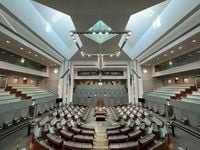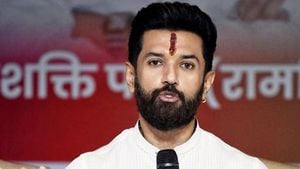As the world marks ten months since Donald Trump’s return to the White House on January 20, 2025, the Indo-Pacific region finds itself at the heart of a shifting global landscape. Trump’s second term, already marked by decisive moves and a reimagining of America’s alliances, is coinciding with a period of remarkable transformation and opportunity for the Asia-Pacific Economic Cooperation (APEC), a forum that has quietly shaped the destinies of nearly three billion people across 21 economies.
For Australia, the story of APEC is deeply personal. It was in December 1989 that the Australian government hosted the first APEC Ministers Meeting in Canberra, after then-Prime Minister Bob Hawke made the bold case for a new kind of regional economic partnership. This partnership, he argued, would bring together the rising economies of the Asia-Pacific, recognizing their shared interest as liberalizing, trading nations in a world eager to move beyond Cold War divisions.
By 1993, the vision had grown. Paul Keating, standing beside President Clinton, announced the elevation of APEC to a Leaders’ Meeting, marking what Keating called a “natural coming together of a new community of nations, represented at the highest levels.” The idea was simple yet profound: build something new that reflected the rapidly changing world, and create opportunities for economic and trade growth that would benefit all.
Fast forward to 2025, and APEC’s influence is staggering. According to recent statements by Australian leaders, APEC now represents a market of nearly three billion people and includes 21 economies. It accounts for more than 60 percent of global GDP and a whopping 75 percent of Australia’s trade. In practical terms, that means one in four Australian jobs depends on trade with APEC economies—a figure that underscores just how vital these relationships have become.
Yet APEC’s success has not come without challenges. The optimism of the late 20th century—that accelerating globalization would inevitably lead to more openness and prosperity—has been tempered by two decades of shocks: the Global Financial Crisis, the rise of nativism and protectionism, a fracturing consensus on climate action, and a pandemic that exposed the fragility of international supply chains. Add to that a land war in Europe and intensifying strategic competition in the Indo-Pacific, and it’s clear that progress doesn’t travel in straight lines.
Despite these headwinds, the vision of Hawke and Keating endures. As one Australian leader put it, “APEC still remains the only international economic forum that brings together economies across the Asia Pacific in voluntary, non-binding cooperation.” For Australia, this has meant not just economic cooperation, but a chance to exercise leadership as a middle power—showing the world how to act in concert for mutual benefit.
This strategic approach has yielded tangible results. Earlier this year, Australia and Papua New Guinea signed the historic Pukpuk Treaty, elevating their relationship to the level of an alliance—the first such alliance for Australia in over seventy years. Just last week, Prime Minister Anthony Albanese warmly welcomed Indonesian President Prabowo Subianto to Australia, announcing the substantive conclusion of negotiations on a new treaty focused on common security. “It is a watershed moment in our relationship – one that is based on friendship, trust, mutual respect, and a shared commitment to peace and stability in our region,” Albanese said.
Economic ties are thriving as well. During a visit to Korea in 2025, Albanese toured POSCO Steelworks, Australia’s largest commercial customer. The trading relationship between the two nations reached $18.2 billion in the last year alone, a testament to the scale and importance of APEC-facilitated trade. The partnership is about more than raw numbers; it’s about innovation and the future. In Korea, Albanese held a piece of zero emissions steel—“the product of our two nations – of our partnership in trade and innovation.” Australia’s role as a supplier of iron ore and critical minerals is powering Korea’s energy transition and green metal industry.
But APEC is not just about economics—it’s about dialogue and stability. In October 2025, on the sidelines of the APEC Summit in South Korea, President Trump and China’s President Xi Jinping met for the first time since Trump’s re-election. The meeting, described by Australian officials as “positive with good outcomes for the world,” underscored APEC’s unique ability to bring adversaries together for face-to-face dialogue. As Albanese reflected, “APEC – and the support for trade generally – can act as a bulwark against conflict. It can incentivise de-escalation – even at the highest levels.”
The forum’s focus on business connections and technological innovation is also paying off. Australia and Singapore recently launched an APEC Centre of Excellence for Paperless Trade, streamlining export and import processes, cutting costs, and reducing barriers for goods moving across borders. These initiatives, leaders say, translate into real benefits for citizens—more stable jobs, better infrastructure, lower prices, and fairer production standards.
Looking ahead, APEC’s agenda is increasingly shaped by the challenges and opportunities of climate change, the global shift to clean energy, and the rapid advance of artificial intelligence. Australia, with its vast natural resources and growing expertise in green technology, is positioning itself as a key partner in the region’s energy transition. “Through its economic and business links, APEC helps us to tackle challenges, and to seize and cement opportunities,” Albanese argued.
As the world becomes more fragmented and uncertain, the role of middle powers like Australia—trusted partners with a knack for facilitation and consensus-building—has never been more important. Forums like APEC, with their emphasis on open, inclusive, rules-based trade, offer a path forward. “Our sense of who we are, what we believe, and the Australian values we cherish all rely on us looking out toward the region and the world. Seizing opportunities. Remaining a trusted partner. Pursuing Australia’s interest abroad – but always with the motivation of making Australians’ lives better here at home,” Albanese concluded.
In a decisive decade for the region and the world, APEC’s blend of economic heft and diplomatic agility is proving more valuable than ever. As alliances shift and new treaties are inked, the Indo-Pacific’s future will be shaped not just by the world’s superpowers, but by the steady, persistent work of those who believe in partnership, dialogue, and the promise of shared prosperity.




